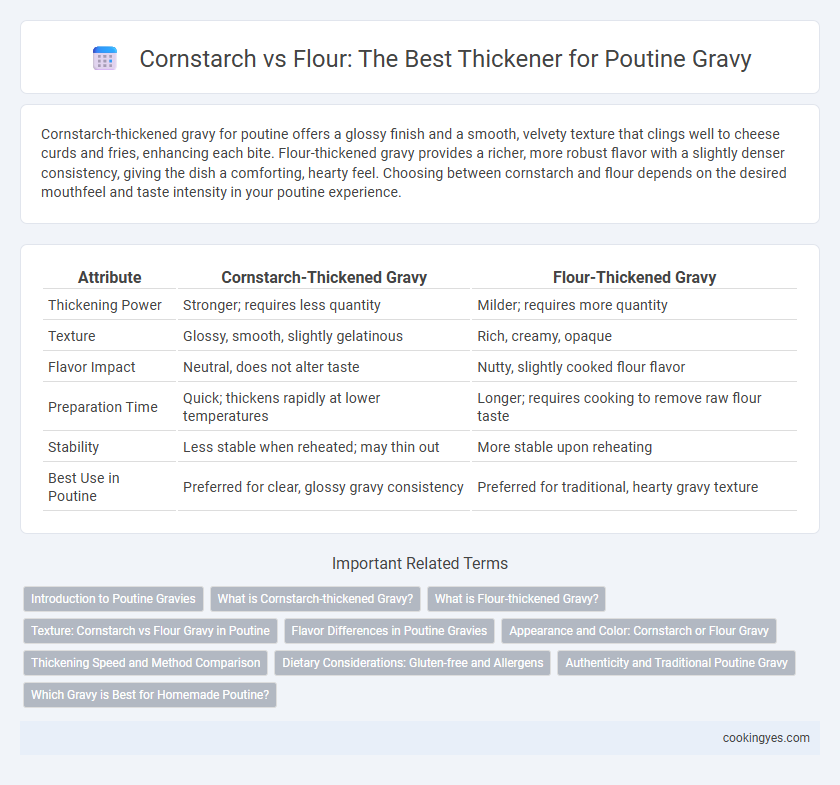Cornstarch-thickened gravy for poutine offers a glossy finish and a smooth, velvety texture that clings well to cheese curds and fries, enhancing each bite. Flour-thickened gravy provides a richer, more robust flavor with a slightly denser consistency, giving the dish a comforting, hearty feel. Choosing between cornstarch and flour depends on the desired mouthfeel and taste intensity in your poutine experience.
Table of Comparison
| Attribute | Cornstarch-Thickened Gravy | Flour-Thickened Gravy |
|---|---|---|
| Thickening Power | Stronger; requires less quantity | Milder; requires more quantity |
| Texture | Glossy, smooth, slightly gelatinous | Rich, creamy, opaque |
| Flavor Impact | Neutral, does not alter taste | Nutty, slightly cooked flour flavor |
| Preparation Time | Quick; thickens rapidly at lower temperatures | Longer; requires cooking to remove raw flour taste |
| Stability | Less stable when reheated; may thin out | More stable upon reheating |
| Best Use in Poutine | Preferred for clear, glossy gravy consistency | Preferred for traditional, hearty gravy texture |
Introduction to Poutine Gravies
Poutine gravies vary primarily between cornstarch-thickened and flour-thickened bases, each impacting texture and flavor differently. Cornstarch-thickened gravy tends to be glossier and lighter with a smoother consistency, enhancing the distinct layers of cheese curds and fries. Flour-thickened gravy offers a richer, heartier texture with a more robust, nutty flavor, contributing depth and traditional authenticity to classic poutine.
What is Cornstarch-thickened Gravy?
Cornstarch-thickened gravy is made by dissolving cornstarch in cold water to create a slurry, which is then added to hot broth or stock to thicken the sauce without altering its flavor. This type of gravy is known for its clear, glossy finish and smooth texture, making it ideal for poutine as it clings well to fries and cheese curds. Unlike flour-thickened gravy, cornstarch thickens more quickly and provides a lighter consistency, enhancing the overall mouthfeel of the dish.
What is Flour-thickened Gravy?
Flour-thickened gravy is a traditional sauce made by combining flour with fat, such as butter or drippings, to create a roux that thickens the liquid base, typically beef or chicken stock. This method provides a rich, smooth texture and deep flavor, essential for authentic poutine gravy. The starch in flour gelatinizes during cooking, resulting in a gravy that clings well to fries and cheese curds, enhancing the overall savory experience.
Texture: Cornstarch vs Flour Gravy in Poutine
Cornstarch-thickened gravy offers a smooth, glossy texture with a lighter, silkier consistency that coats the fries and cheese curds evenly without becoming heavy. Flour-thickened gravy provides a denser, creamier mouthfeel with a slightly opaque finish, resulting in a heartier bite typical of traditional poutine. The choice between cornstarch and flour directly impacts the gravy's viscosity and how it interacts with the crispiness of fries and meltiness of cheese curds.
Flavor Differences in Poutine Gravies
Cornstarch-thickened gravy in poutine offers a cleaner, more neutral flavor that allows the cheese curds and fries to shine without added heaviness. Flour-thickened gravy delivers a richer, deeper, and slightly nutty taste that enhances the overall savory profile of poutine. The choice between cornstarch and flour directly influences the texture and mouthfeel, with cornstarch providing a smoother, glossy finish and flour contributing a more robust, velvety body.
Appearance and Color: Cornstarch or Flour Gravy
Cornstarch-thickened gravy for poutine typically exhibits a glossy, translucent appearance with a rich amber color, enhancing the dish's visual appeal. In contrast, flour-thickened gravy has a more opaque, matte finish and tends to be darker and creamier in color due to the caramelization of flour during cooking. The choice between cornstarch and flour affects not only texture but also the distinctive look of classic poutine gravy.
Thickening Speed and Method Comparison
Cornstarch-thickened gravy for poutine offers faster thickening due to its immediate gelatinization at higher temperatures, resulting in a glossy, smooth texture with minimal cooking time. Flour-thickened gravy requires longer simmering to eliminate its raw taste and fully develop thickness through starch granule swelling and gluten interaction, which can produce a denser, more opaque consistency. Choosing between the two depends on desired preparation time and texture, with cornstarch favored for quick, clear gravies and flour preferred for richer, more robust flavors.
Dietary Considerations: Gluten-free and Allergens
Cornstarch-thickened gravy offers a gluten-free alternative ideal for those with gluten intolerance or celiac disease, reducing allergen risks compared to traditional flour-thickened gravy. Flour-thickened gravy, typically made with wheat flour, contains gluten and poses challenges for individuals with gluten sensitivity or wheat allergies. Choosing cornstarch as a thickener ensures poutine remains accessible without compromising texture or flavor for those requiring allergen-conscious options.
Authenticity and Traditional Poutine Gravy
Authentic poutine gravy is traditionally thickened with a flour roux, providing a rich, velvety texture that complements the crispy fries and fresh cheese curds. Cornstarch-thickened gravy, while quicker to prepare and gluten-free, lacks the depth of flavor and classic mouthfeel associated with traditional Quebec-style poutine. For a truly genuine poutine experience, a slow-cooked flour-based gravy preserves the heritage and culinary integrity of the iconic Canadian dish.
Which Gravy is Best for Homemade Poutine?
Cornstarch-thickened gravy offers a glossy, smooth texture with a clean, neutral flavor that enhances the cheese curds and fries without overpowering them, making it ideal for homemade poutine. Flour-thickened gravy provides a richer, more robust taste with a slightly grainier texture, adding depth and comfort to the dish. For homemade poutine, cornstarch gravy is best for a lighter, silky finish, while flour gravy suits those seeking a traditional, hearty experience.
Cornstarch-thickened Gravy vs Flour-thickened Gravy for Poutine Infographic

 cookingyes.com
cookingyes.com